By NMA New Hampshire Member Jim Burton
One of our ‘bucket list’ items has always been to spend a month touring England, Scotland, and Wales. The UK is the land of my ancestors, and my American wife can’t get enough of everything British. Not only is the scenery on this island country stunningly beautiful, but the last 2000 years of human habitation has left some quaint villages, vibrant cities, stately manors, castles and gardens that are well worth visiting. In addition to the scenery, the British people are warm and welcoming, and the food is not bad either.
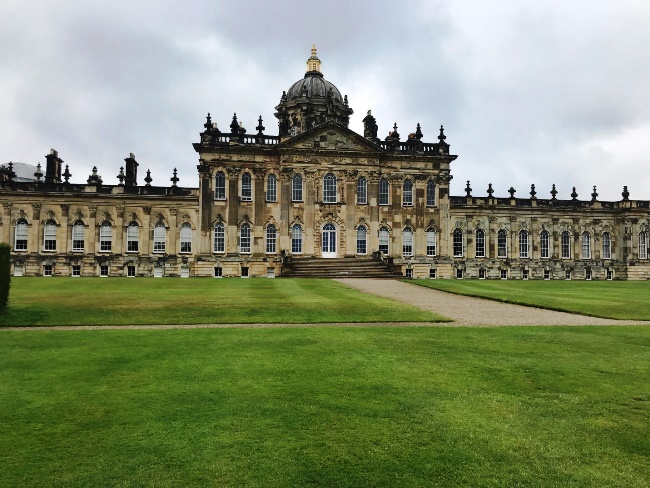
Castle Howard in North Yorkshire, one of England’s many stately mansions.
The only issue with such a tour is you must rent a car, sit in the right-hand seat and drive on the left-hand side of the road. Roads are very narrow and winding, while speeds are much faster than those you will experience in the US.
Add in livestock, walkers, horse and riders, bicycles, stone outcroppings, narrow bridges, and 8-foot hedges that come right to the edge of the road, and a chauffeured air-conditioned coach or train begins to look very attractive.
The problem with those modes of transportation is they only go to major tourist attractions. We wanted to tour areas where Americans rarely visit, and a car is the only way to do that.
Nearly all vehicles in the UK come with a manual transmission. Automatics are exceedingly rare and exist primarily for American tourists. Since we own three cars with manual transmissions and I have been driving manuals for over 50 years, a small manual transmission vehicle was our choice for this trip.
If you are not a skilled manual transmission driver, I would strongly recommend that you select an automatic. You need to be able to shift with your left hand without taking your eyes off the road, and you need to be skilled in using the parking brake to help you get started going up steep hills. The UK is no place to learn how to drive a manual. If you are concerned about shifting with your left hand, there is no need to worry. Your brain takes over, and it takes around a mile or so to become efficient. The pedals on a UK car are identical to those on a US model.
The origins of driving on the left-hand side of the road date back 800 years or so when knights on horseback would raise their sword with their right hand to defend against an oncoming knight. Although we sometimes saw horses with riders, most were female riders and none appeared to be wearing swords. As the rest of the world standardized on driving on the right, Britain stubbornly clung to tradition. Driving on the left is indeed the opposite of driving on the right. Left-hand turns are easy, and right-hand turns require that you yield to traffic going both directions on the cross road.
When it comes to roads, Britain is very different from the US. Most of the roads were foot paths and horse trails that were laid out 1000 years ago. Some of the major motorways even date back to Roman times 1000 years earlier. Over time, these country and city roads were widened as much as possible and paved over.
Unlike the US where there is unlimited space on the side of the roads, many UK roads are bounded by rock walls, hedges, and buildings. Bridges are another issue since many were designed for horses with the occasional ox cart. The UK refuses to demolish these 1000 year old historical landmarks, and for good reason. These features are part of the county’s character and will remain so forever.
Finding your way around these 1000 year old roads is a significant chore. A GPS is a requirement if you want to explore the rural back roads of Britain. You will also want to have at least one cell phone with a map application, a paper map, and a navigator. On our trip, my wife was our navigator.
The navigator can help to identify turns and exit roads off the roundabouts while you work to drive safely. The GPS may not react fast enough in major cities with tall building, and many roads close together. That’s where a navigator is handy. Cell phones can be used when GPS cannot locate attractions and businesses. If you plan to rely only on your cell phone for navigation, be warned that cell coverage is spotty in the rural UK.
One advantage of UK roads is the traffic is lighter than it is in the US. Only on the motorways and in the cities do you get the heavy traffic you commonly see in the US.
If you begin your journey at the airport and head out to the countryside, that will give you time to become acclimated to the car and UK roads without the fear of traffic.
Another advantage to the UK is, for the most part, the drivers are almost always polite and patient with you. They smile and wave with one hand as they pass by. If you make a mistake, they will honk at you and wait patiently until you remedy the situation. Often you will see them stopped three feet from the side of your car patiently waiting for you to clear the intersection so they can proceed.
The ultimate goal of UK drivers is to avoid hitting another vehicle at all costs. A final advantage is UK drivers are incredibly skilled at precision driving. They almost always signal, and they know how to drive their vehicles extremely close to oncoming traffic without having a collision. It is not unheard of for side view mirrors to pass within inches of each other at high rates of speed.
The UK has very few traffic lights. You will only encounter them in the big cities or on roundabouts on major motorways. You can often drive for hours without seeing one. When you do encounter one, you may be puzzled by the yellow and red lights coming on together for 2 seconds before the green light. That is to allow you time to shift the transmission into first gear and let out the clutch on your manual transmission vehicle.
The UK also doesn’t have many overpasses like the US has. Just about every intersection is a roundabout. When you encounter one of these, you always go left around the roundabout and exit to the left onto the road you want to take.
Roundabouts vary in size from a simple 8-foot raised painted dome in the middle of the intersection where two roads cross, to huge multilane roundabouts with multiple traffic lights where major motorways cross.
The key to successfully negotiating a roundabout is to always yield the right-of-way to all vehicles coming from your right. You should position yourself in the correct lane before entering the roundabout. Lanes are marked clearly with writing on the pavement. If they are not marked, the left lane goes left, the next lane(s) go straight, and the right lane goes to the roads off to the right side of the roundabout.
Sometimes the left lane is a combination left turn and straight lane. Always use your directional signal if you are going right or left. There is no need to use a signal when entering to go straight ahead. As you are preparing to exit the roundabout, signal for a left-hand turn onto your selected road.
Roundabouts are a very efficient form of traffic control and work very well if you execute them properly. After the first 100 or so, you will become an expert.
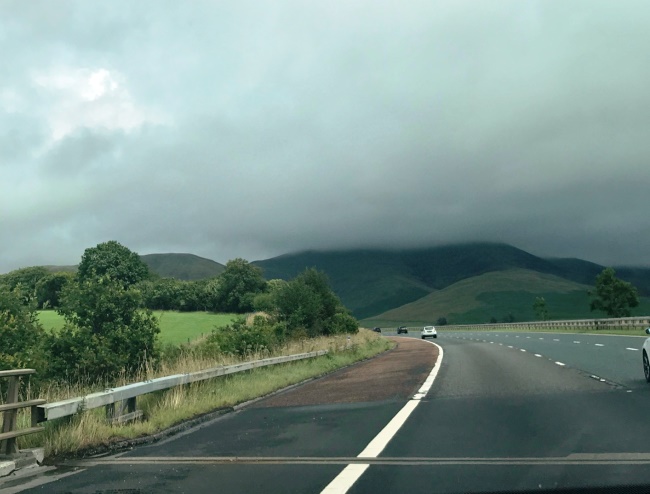
Motorways in the UK are wide, beautiful roads with a posted speed limit of 70 mph. Slower traffic keeps to the left, and faster traffic passes on the right. Most UK drivers signal for a lane change. Only rarely will you encounter a traffic jam.
As you move off the motorways onto secondary roads, you are faced with a number of issues that you will not encounter in the US. Secondary roads are by far the most dangerous roads in the UK. They vary from a two-lane highway, just like we have in the US, to a seven-foot wide path between hedges. The latter is called a “single track road” and they always have wide spots along the way to allow two cars to pass.
The speed limit on the secondary roads outside of villages is 60 mph. Realistically you will be going much slower in case you round a corner and encounter a vehicle coming from the other direction.
As I said before, UK drivers are incredibly polite and will usually pull over and flash their headlights to let you get by. On extremely tight roads, you will need to fold your side mirrors inward as you creep along at 2-mph only inches apart. Both of you may need to get out of your cars and strategize about how best to pass each other in impossibly tight situations.
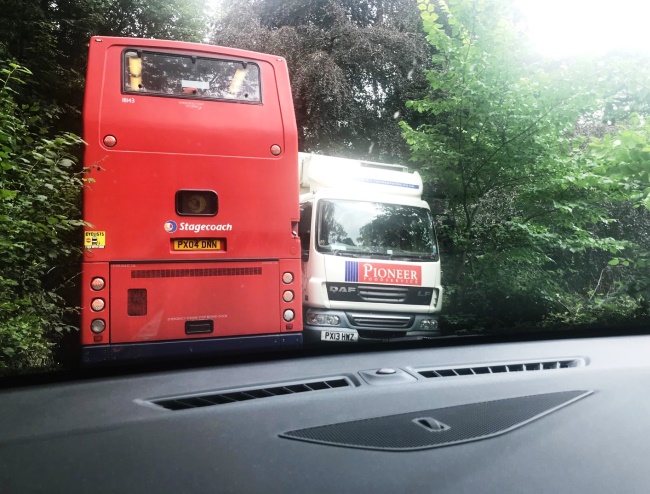
The UK has a slightly different definition of “traffic jam” from the US. Here, a tour bus and lorry squeeze by each other on a narrow road without scraping. Each driver folded in the side mirrors to clear the way.
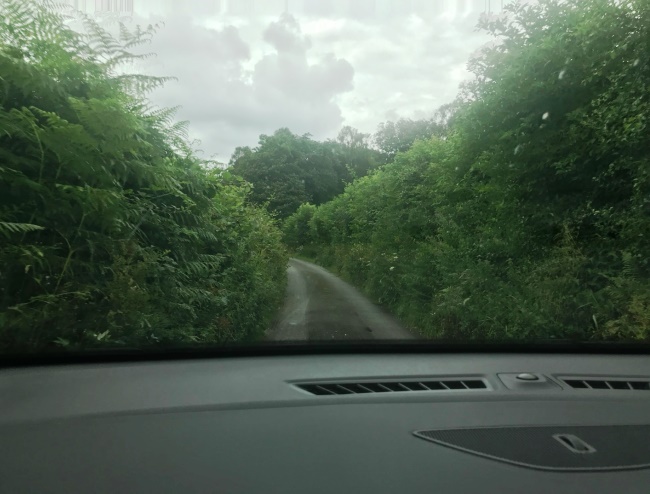
The hedges on this single track road make it extremely difficult to see oncoming traffic. If you encounter a car coming from the opposite direction, one of you will need to back up to a wide spot to allow your cars to pass.
Pay special attention to the warning signs. Unlike in the US, these signs point out real dangers and identify locations where many accidents have occurred in the past. Slow down and pull as far over to the left as you possibly can without getting into a hedge. Bear in mind that most hedges in the UK are hiding a rock wall.
If you encounter a sign that says “Disregard your GPS and follow the signs,” you are strongly advised to do that. If you don’t, you will encounter extremely narrow roads that are nearly impossible to pass without scraping the left side of your car.
Always be on the lookout for single lane bridges. Most are marked but not all of them, especially in remote areas. Usually, they have signs stating who has the right-of-way and who needs to yield.
I remember one ancient stone bridge where I literally had 6 inches between my folded in mirrors and the sides of the stone bridge. And that specific bridge had a slight curve to make things even more interesting.
Most dangerous stretches of road have temporary traffic lights that allow one direction to proceed while the opposite direction waits.
When going through villages and cities, people park in the travel lanes. If your lane is blocked, you must yield to oncoming traffic until the way is clear.

Most dangerous areas are well marked. It is wise to heed the danger signs and adjust your driving accordingly.
The UK is very different from the US in that vehicles have the right-of-way over pedestrians. People will only cross in front of your car if they have a green light in a crosswalk or if you stop and wave them across. If the street is full of people, they will quickly get to the side of the road to let you pass.
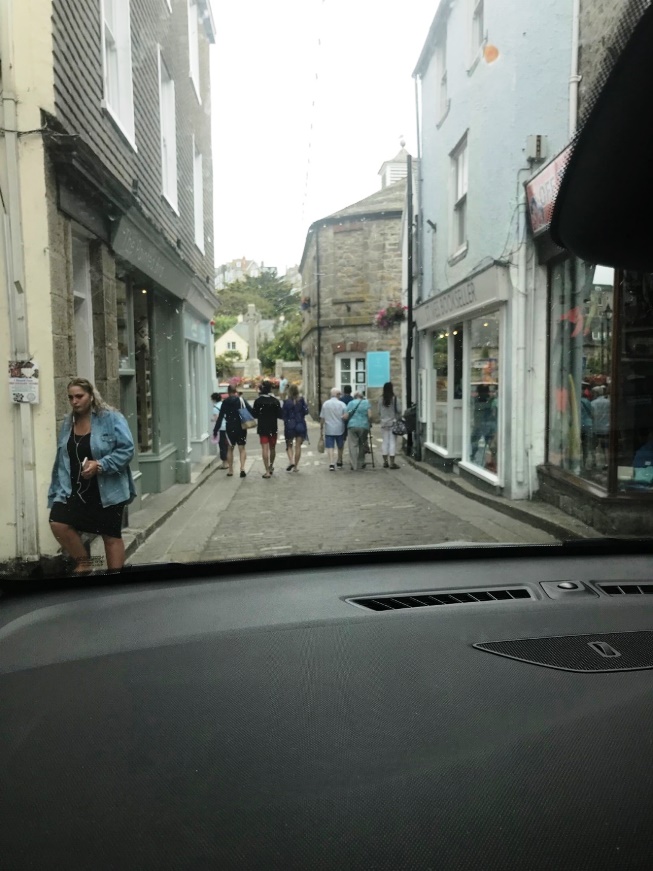
No worries here. These pedestrians gladly stepped aside to let me pass.
You will also encounter bicyclists and walkers. The walkers will usually quickly jump to the side of the road when they see you coming. Bicyclists are allowed to use the entire travel lane if they desire. You will also encounter a lot of motorcyclists who are allowed to “lane split” or pass you on the dividing lines between lanes. They tend to come out of nowhere and pass you at high rates of speed.
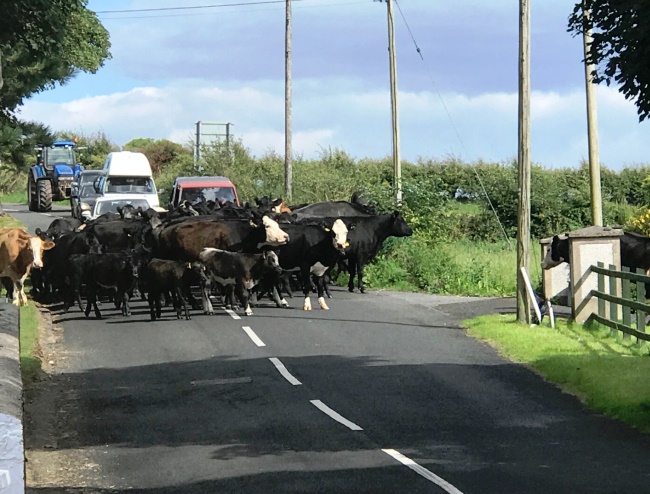
We took this farmer’s advice and quickly moved our car off the road to let his cattle come down the road.
Unlike in the US, you will see a lot of livestock on the roads of the UK. Farm animals have the right-of-way over vehicles. If a farmer flags you down and advises you to get off the road, please do so very quickly. You are minutes way from having a heard of sheep or cows come stampeding down the road. Be very careful with farm animals in the road. If you hit and kill one, you are responsible for reimbursing the farmer for the value of the animal.
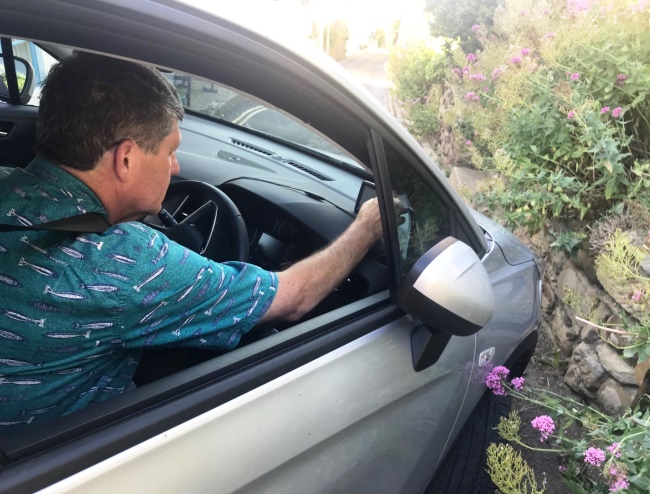
Here I am cursing at my GPS for sending me up a narrow dead-end road in Cornwall. I had only a few feet between stone walls to turn the car around. The elderly owner of the house next door came out to laugh and tell me no one has been able to turn a car around in that space until now.
Driving into coastal villages can be a real challenge. The roads are narrow, sidewalks are non-existent and they are full of tourists. These are some of the oldest towns in the UK and buildings are extremely close together. You will definitely need to fold in the side mirrors and take extra care as you squeeze between buildings. Most roads are one-way and the GPS will not always be accurate. If a truck happens to get stuck in a downtown street, traffic could be snarled for hours. It is best to find the nearest parking lot, dump the car and walk to the town.
Driving into cities is a major chore that is to be avoided if at all possible. Many cities have signs directing you to a parking area at the edge of the city where you can park and take public transportation into the city. Naturally, my ego said “no” and we proceeded into downtown Newcastle-Upon-Tyne. The GPS couldn’t keep up and I missed my turn. After a few more misses, I found that I was back close to where I started. A trip the wrong way on a bus-only road resulted in a loud honk from an oncoming bus.
At that point, I said I would take the next parking garage no matter where it was. I pulled in and found the spiral ramp up to be extremely narrow. My car was inches away from the cement wall. When I finally found an open space, I could not possibly squeeze my car into such a narrow space. Finally, I exited the garage in frustration and left the city without seeing anything but a few of the roads and the parking garage. If you do choose to go to cities, get the car parked as rapidly as possible and take taxis, Uber or public transit. Don’t learn the hard way like I did.
Parking can also be a real issue in the UK. Free parking is rare, so expect to pay most every place you go. You can use coins, a credit card or a mobile app to pay. I found that American credit cards are often rejected for some reason. Not every parking area will let you use a mobile app, so always carry a good supply of coins.
Although there are many mobile apps, I found RingGo and PayByPhone to be widely used. Since you preloaded the app with your credit card and car registration number, all it takes is a few clicks to pay for parking. A major benefit of using an app is you can extend your stay without returning to the car. Many parking lots have license plate readers that will capture your plate and time of entry and exit. If that does not match up with what you paid, you risk receiving a $100 ticket. We were told that parking fines are so backed up in the UK that it is unlikely you will ever receive a ticket.
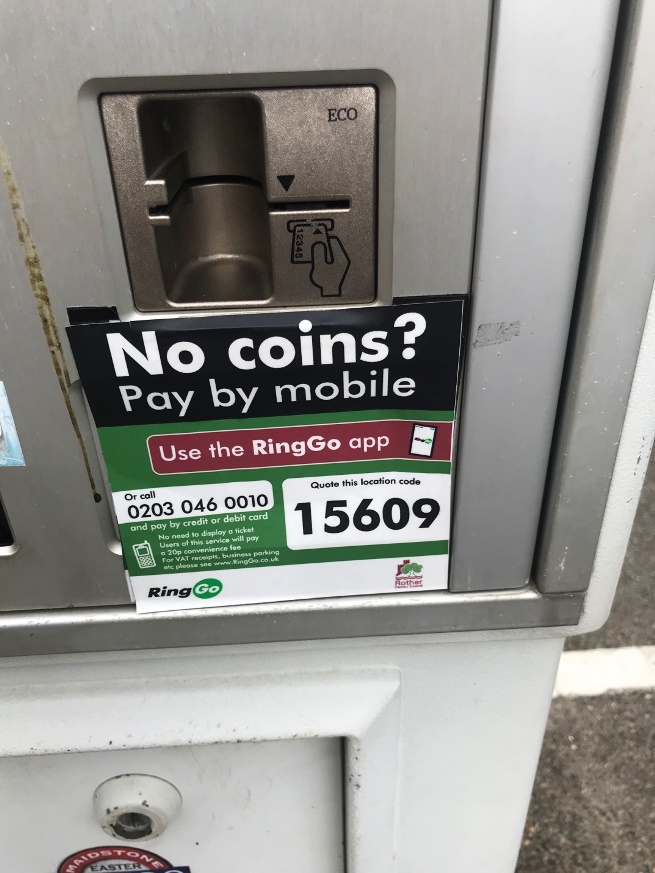
There are no parking meters. You pay at a pay station like this one using coins, credit card or a mobile app.
Roads in the UK are extremely challenging compared to American roads. Although I have no statistics, I suspect that accidents are far more common and severe than in the US.
Due to small cars and fast speeds, most accidents result in a totaled vehicle and a stay in the hospital. On a previously two-week trip to the UK, we saw the aftermath of five serious accidents. For this trip, we only saw one. Because of the high accident rate, the UK takes an extremely heavy-handed approach to monitoring people and traffic. There are cameras everywhere. The only place you can guarantee there are no cameras is in the bedrooms and toilets. If an incident happens, police generally have multiple camera feeds from all directions that document what actually happened. If you think that no one saw you roll through that stop sign, think again. There is no privacy in public places in the UK.
Traffic calming is also all over the villages, cities, towns and neighborhoods. As you enter, you will be greeted with a lighted board showing your speed. You will experience narrowed streets, curb extensions blocking one lane, raised median islands, one-way streets, pedestrian-only areas, speed bumps and speed tables. Another form of traffic calming is the number of cars parked in travel lanes. You literally can’t go faster than the speed limit as you weave back and forth, avoiding all the parked cars.
Signs everywhere warn you that speed cameras are recording your speed. You don’t know where these cameras are until it is too late, so it is best to go the posted speed limit or slightly under.
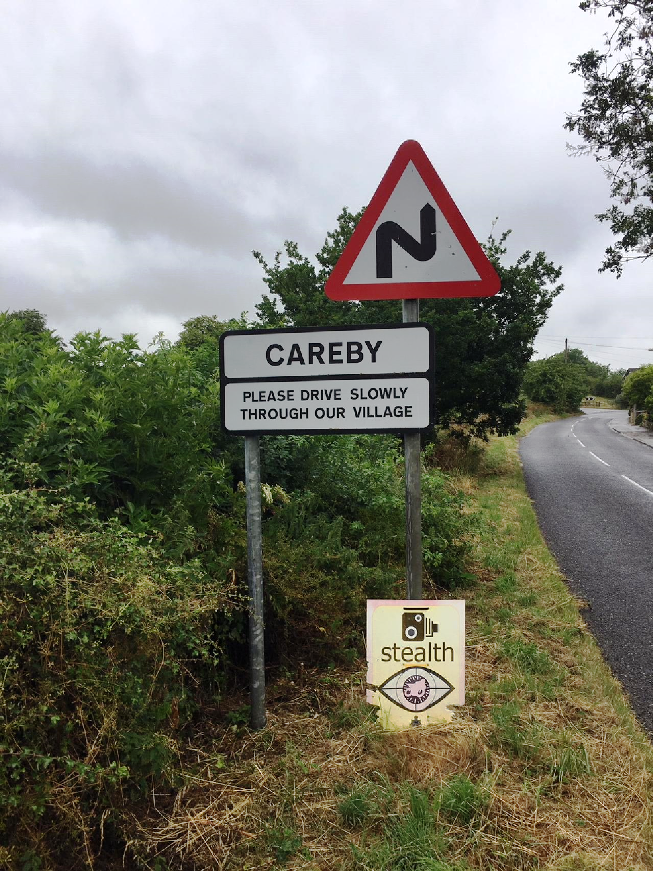
Notice the warning sign outside of this Lincolnshire village. The “stealth” warning means the camera is probably hidden. Failure to obey the speed limit could result in a $125 photo radar ticket being mailed to the owner of the vehicle.
In the UK, traffic enforcement cameras are everywhere, at least the warning signs are. As you cruise the roads and motorways, you will see thousands of warning signs, speed cameras mounted in yellow boxes on the side of the roads, overhead cameras, safety vans and motorcycle officers with speed cameras. The vans can be parked on the side of the road, or they can operate from overpasses.
Police cars and motorcycles often stop and set up portable speed cameras on tripods. One officer will record your speed and take a picture of your car, while an officer down the road will pull you over. All of these devices will measure your speed and log a violation if they find you exceeded the speed limit by even 1 mph.
Modern cameras don’t flash like the older one did. You won’t see anything. At night, speed cameras use infrared light to avoid blinding drivers.
One of the most onerous speed monitoring technique is the “Average Speed Check.” These exclusively occur on motorways where there is construction happening. The speed limit drops to 50 mph and a bank of license plate reader cameras will log your plate and the time the plate was captured. Every mile or so, another bank of cameras will capture your plate and calculate your speed. If you exceeded 50 mph, it will log a violation. Since construction zone can go for 20 miles or more, you risk logging a lot of violations if you speed. You will find that just about everyone goes 50 mph or less in these zones.
It is nearly impossible to drive in the UK without being snapped by a speed camera or red light camera on occasion. If it does happen to you, there is no need to panic. I have been snapped 5-6 times on my trips and I have yet to receive a ticket.
Two years ago I rolled through a red-light in St. Andrews, Scotland as I was checking out the golf course. The cross road was deserted at the time but I got a bright blue flash as the camera took my picture. The law in the UK states that a police officer must review violations and issue a ticket within two weeks of the alleged violation. With thousands of snaps per minute across the UK, not all of them will result in a fine. But the fear of being snapped and fined is enough to keep most drivers within the posted speed limits.
Wrap-up
A driving trip to the UK can be a trip of a lifetime. There is so much to see and experience and driving a car is the only way to take in that experience. A bus or train simply will not get you to that remote castle or local restaurant.
If you choose to drive, bear in mind that the UK is not the US and things are very different. You must learn how to drive like a UK resident and you are strongly advised to adhere to all of the laws, especially the speed laws. Driving in the UK is very dangerous. Only you can decide if that danger is worth the risk. If you do decide to embark on such a trip, it will bring you memories that will last a lifetime.
Jim Burton was born in the US and has lived here all of his life. He has never lived in the UK or Europe. His wife is terrified of driving in the UK.






